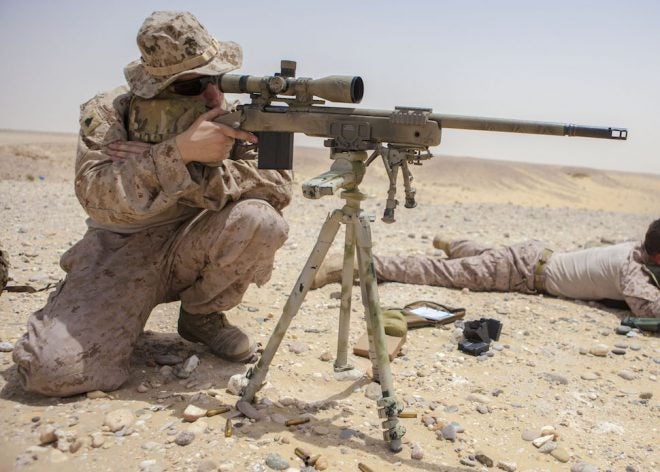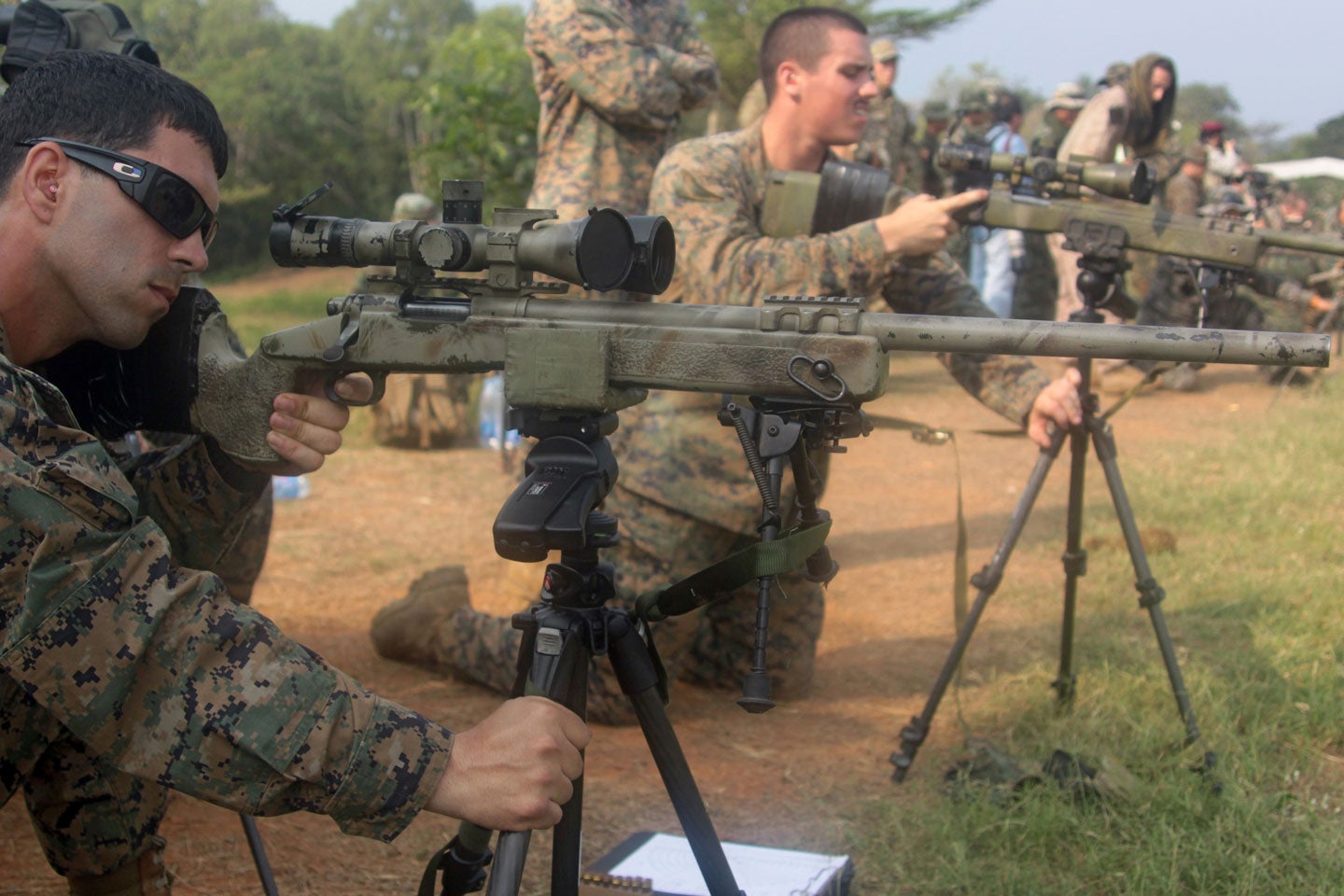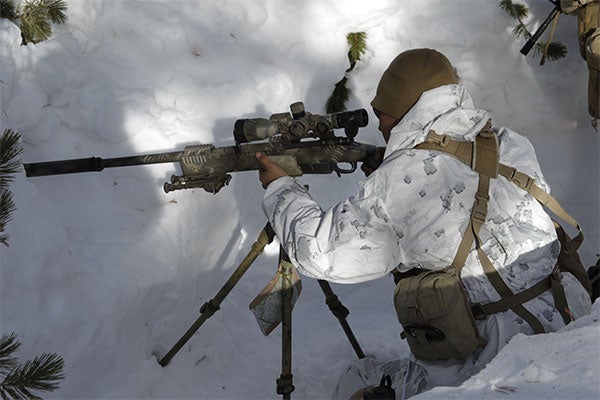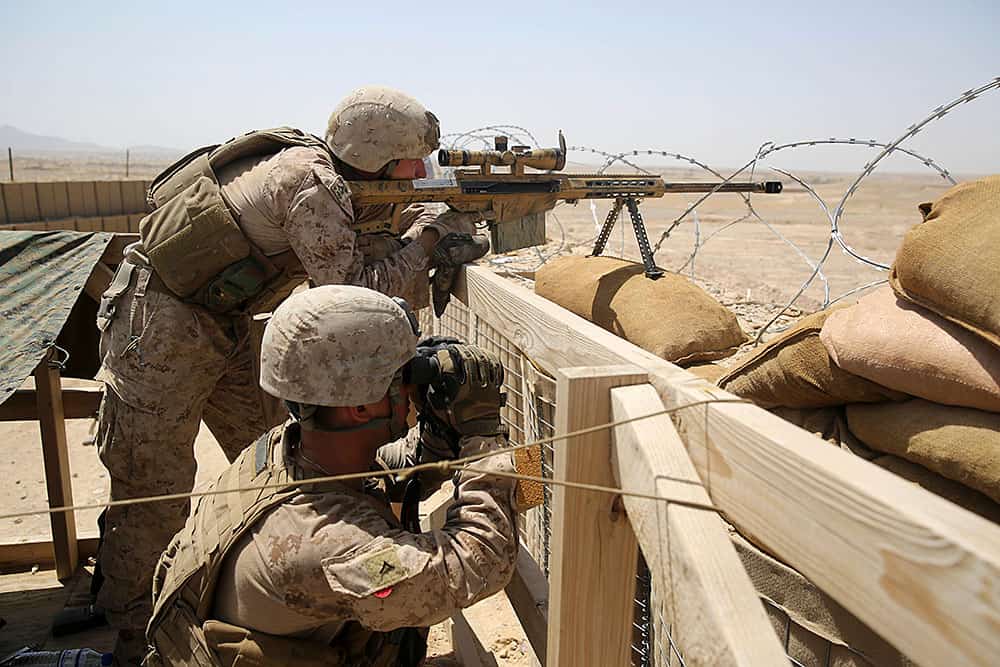Note- This article is the second portion of an earlier article that contiues the discussion of the dynamics of being a member of a Marine Scout Sniper platoon. To read that article, please click here.
The training, weapons, and gear that takes place in Sniper platoons is very different than in line platoons. To begin with, many Sniper platoons are authorized to use gear that is much more conducive to their mission set such as MICH helmets that allow them to gain a solid cheek weld with the new M40A6s, lighter plate carriers that allow platoon members to carry more weight, better boots that allow them to run faster in full gear. Even the set up is different. Usually, plate carriers are set up with nothing on the torso portion to allow a better prone position. Many platoons use a belt system where all the equipment is loaded on a belt. Not only does this help the aforementioned prone position, but in a worst case Escape and Evade scenario, members can ditch their heavy armor altogether and move much faster with just the bare essentials of ammunition, survival gear, and water.
Weapon systems are obviously different too. Many platoons have their members pistol qualified because they have to be armed with a secondary weapon other than the long guns. The primary weapon system of everyone is the M4A1 with fully automatic selector switch and the Surefire suppressor. This is to both conceal their position when returning fire better and to lay down much more firepower because the teams travel in much smaller groups than a line platoon or squad will travel in. Usually, the HOG team leaders carry the M40A5/A6, while the assistant team leaders carry the M110 SASS, an AR10 variant built by Knight’s Armament (although sometimes these weapon assignments can change to suit the mission). The .50 Cal Barrett SASR, being mainly a 3 MOA anti-material weapon is usually humped by some poor PIG while on patrol. Some platoons even integrated the 5.56x45mm NATO Mk.12 DM rifles for additional firepower while on deployment. M249 SAWs were also carried by team members during OIF and OEF, again because it adds firepower to an already small team. All of the long guns are usually qualified with out to 800 meters with the SASS, and 1000 meters (a “grand” as it is known in platoons) with the M40A5s/A6s.
The way the ranges are completed on the long guns is very different than you might expect. Everything is geared to training for reality. This involves running the yard lines as fast as possible between each session of fire. Bags are kept between shooters legs to minimize a profile, ammunition is kept out of sunlight so temperature doesn’t affect the rounds, meticulous notes are kept for each shot in addition to recording the ammunition lots used. Possibly the biggest thing that makes the difference here is the shooter-spotter dialogue that takes place. This is absolutely essentially to achieving accurate hits on target. Standards are kept very high here as well, if a PIG or student at the school house leaves a zipper on a backpack open, he can expect the entire contents of that backpack to be dumped all over the range, with him having to run to pick all of it up so as not to leave a target indicator behind.
While not working with the weapon systems there are numerous other training exercises that Sniper platoons engage in. Stalking, land navigation, sketches, and observations (“Obs” for short) are three of the most complex and essential to the platoon’s capabilities. Stalking involves starting maybe 600-1000 meters away from an instructor on glass. In a limited time period, the stalker has to make his way as close as he can to the instructor in order to get a shot off with blanks. Once a shot has been fired, a “walker” comes over to the shooter while the instructor holds up a paper card. The shooter has to positively ID the card in order to score well on the stalk lane. Then, with the instructor looking directly in the vicinity of the shooter, he has to take another blank shot. If he passes this, then he has achieved a “100” on the stalk lane.
Field sketches and observations are done to enhance a platoon member’s situational awareness capabilities through intricately sketching the scene from a certain position. This is to be able to bring back to a higher command, so that command knows exactly what the view from that position is. Granted, cameras exist today, but sometimes these go down. Observations are done where the platoon has to write down military objects that are barely viewable at a distance away from their position using a set of binoculars and a spotting scope. This is especially helpful in scanning and looking for attention to detail.
The HOGs in these platoons usually go on to be instructors at the school houses, or bounce higher up the chain of command in their platoon to being a Chief Scout, or platoon sergeant. Some of them even become infantry warrant officers as gunners because of their deep knowledge of various weapon systems. Others go back into the infantry and continue their careers there because there is very little career progression in the 0317 MOS. Then others also just get out after 4 or 8 years of being in the service. PIGs usually don’t end up re-enlisting and mostly get out themselves after a 4 year contract in the infantry. Usually, these Marines are very smart and motivated to begin with, and seeing the Marine Corps for the archaic and slow organization it is, choose to take their talents to the civilian world or even contracting. However, this retention problem isn’t just related to PIGs, but really is a Marine Corps wide issue that that been plaguing the service for some time.
As for myself, I was in 1/9’s Scout Sniper platoon for a year in 2012. I received a chance to go to the Basic Course and eventually failed the school, not returning. I was one of those 50 percent drop outs that we covered in an earlier article. When I came back to my Sniper platoon, I was on a sort of downward decline of motivation, we call it being a Terminal Lance in the Fleet. I wasn’t as proficient and I had issues working with the other guys in the platoon and was thus kicked back to a line company. The spiral was entirely my fault, being younger and immature, not realizing the consequences of my actions, etc… Either way, I completed the next two years of my infantry contract with Bravo 1/9, and deployed with them to Afghanistan for a second time. In retrospect, being in the platoon was the highlight of my career when it comes to the amount of knowledge and training I accomplished. But on a personal level, I was probably much better suited to a line company.
 Your Privacy Choices
Your Privacy Choices




